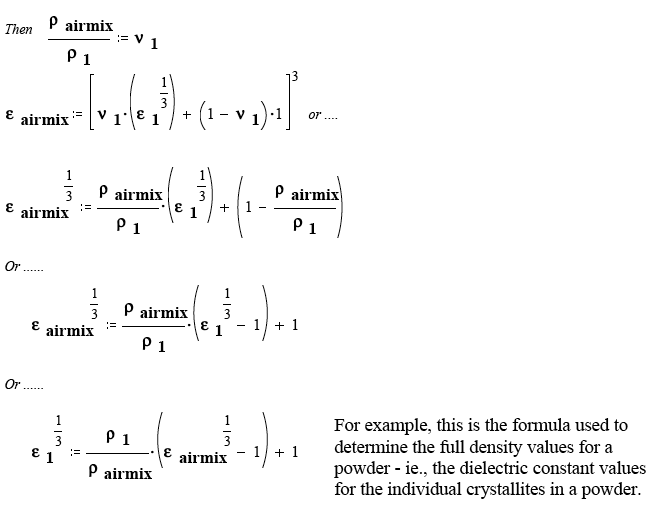These are approximate equations for deducing the complex dielctric constant values of mixtures, assuming the theoretical full-density material dielectric values are known. Used in reverse, one can extract full density values from measurements on two-component mixtures, the most common of which is air-solid mixtures .
Note: This must be used in a full "complex math" form - ie., using j as SQRT(-1)
Landau, Lifshitz, Looyenga Mixing Formula :
Reference:
- (1) Looyenga, H. 1965 Physica 31 , pg 401-406
- (2) Landau L D and Lifshitz E M 1960, Electrodynamics of Continuous Media. Vol. 8, Course of Theoretical Physics (Oxford: Pergamon)
Special Case of Air ( or a Gas) Being One of the Two Components :
If material #2 is air, then ε2 is unity, and the mass of material #2 is ~ zero . In this case, the density of the mixture is that of material #1 (theoretical density) multiplied by the volume fraction of material #1.

Outline of Preferred Laibinis Mixing Equations for Liquids
Equations Recommended by Laibinis for Determining the Debye Parameters for a Mixture Of Two Liquids

Reference:
- “Mixing Rules for the Dielectric Properties of Solvent Mixtures at Microwave Frequencies”, J. Lou, T.A. Hatton, and P. E. Laibinis , Microwave: Theory and Applications in Materials processing IV, Ceramic Transactions, Vol. 80, Pg 115, Edited by D. Clark, W. Sutton, D. Lewis
Please feel free to phone or e-mail and discuss possible measurements. We treat all communications as confidential unless advised otherwise.
